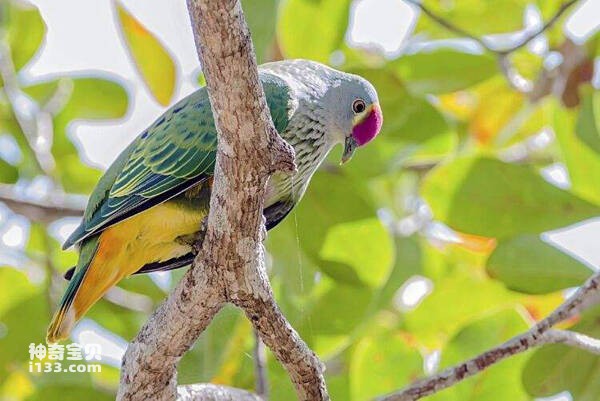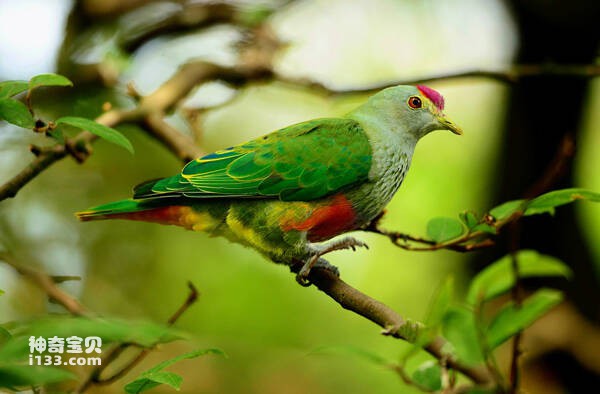Ptilinopus regina
IUCN
LCBasic Information
Scientific classification
- name:Ptilinopus regina
- Scientific Name:Ptilinopus regina,Rose-crowned Fruit-dove
- Outline:Landfowl
- Family:
Vital signs
- length:20-24cm
- Weight:85-125g
- lifetime:No textual research information is available
Feature
It has a pink head, green wings, a gray chest and an orange-yellow belly
Distribution and Habitat
It is found in Australia, Indonesia and East Timor.
It inhabits a variety of ecological forest environments, including tropical rainforests, forest belts, monsoon rainforests, and mangroves. It lives in dense primary forests, but also appears in shrubland and sparse woodland.
Appearance
It is 20-24 cm long and weighs 85-125 g. It is a very beautiful small pigeon with a pink head, green wings, a gray chest and an orange-yellow belly. There are five subspecies, and the forehead and crown of the cap vary from dark pink to Burgundy, with a yellow border. The chin and throat range from yellow to cream, the head and neck are mixed with greenish-gray, and the rest of the upper body is green to the lower neck. The wings are green and have pale fringes, and the primary coverts are darker in center. It has large dark blue spots. Chest light gray to green, spotted. There are distinct and extensive pink-purple spots in the center of the chest. The orange on the chest gradually merges with the yellow on the belly and under the tail. The tail is green. The beak and legs are gray-green.
The spots on the female's chest are smaller and dimmer than those of the male. Young birds do not have purple crowns. The feathers have yellow edges. The tail is gray instead of yellow. The d
Details
The Rose-crowned Fruit-dove (Ptilinopus regina), with five subspecies, is a very beautiful small pigeon.

Pink doves often act alone and rarely cluster, sometimes gathering more than 5 small groups, and mixing with other doves to form a beautiful and spectacular flock of doves. These birds are particularly active and agile when foraging in trees, hanging upside down from branches when necessary and picking up fruit with their beaks. Many rituals are formed between couples during trips and brief stays, much like other birds of the genus, where family members smoothen feathers and greet each other with birdsong.
The pink-top fruit dove partially migrates or descends vertically, having a tendency to be nomadic in dry areas, especially within its range of distribution. Some nesting areas are found in southern Tasmania. During the day, in the heat of the summer, the pink dove hides among the forest canopy and leaves, and flies away in a flock with a whirring flap of wings when it senses danger.
It feeds mainly on plant fruits, commonly blueberries, figs, and palm fruits.

The breeding season varies from place to place. In southern New South Wales, fruit is abundant from mid-October until February. The nest is built on a small platform in the branches of trees, and is also placed in the branches of low shrubs or vines, and its height is not more than 6 meters above the ground. However, it can sometimes be seen in some buildings as high as 30 meters. Some nests are also placed on mangrove tree branches suspended in the water.
Each clutch lays 1 white egg, which incubates for 16-18 days. In captivity, chicks weigh about 7 grams at birth and are partially covered with white fluff. Their growth is very fast, and with the right aviary and diet, they can grow to five times their birth weight within a week. In the wild, chicks nest for a surprisingly short time, lasting only seven or eight days, compared to 11 to 14 days in a cage. Plumage between 100 and 120 days. Adult birds may have two litters per year.
This species is not globally endangered. Although it is abundant in some countries and distribution areas, it is localized in the Wallace region and is very common on some very small islands. However, due to the threat of habitat loss and fragmentation, the population in New South Wales, Australia, is estimated to be between 1,600 and 2,000 individuals (2015), so it is still listed as rare or vulnerable in these parts of the country.
Listed on the International Union for Conservation of Nature (IUCN) 2012 Red List of Threatened Species ver 3.1 - Not Threatened (LC).
Protect wild animals and eliminate wild meat.
Maintaining ecological balance is everyone's responsibility!








